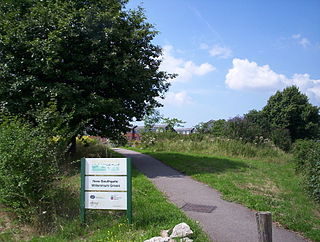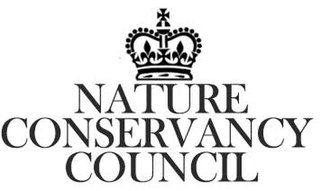
A site of special scientific interest (SSSI) in Great Britain, or an area of special scientific interest (ASSI) in the Isle of Man and Northern Ireland, is a conservation designation denoting a protected area in the United Kingdom and Isle of Man. SSSI/ASSIs are the basic building block of site-based nature conservation legislation and most other legal nature/geological conservation designations in the United Kingdom are based upon them, including national nature reserves, Ramsar sites, Special Protection Areas, and Special Areas of Conservation. The acronym "SSSI" is often pronounced "triple-S I".

English Nature was the United Kingdom government agency that promoted the conservation of wildlife, geology and wild places throughout England between 1990 and 2006. It was a non-departmental public body funded by the Department for Environment, Food and Rural Affairs (DEFRA) and gave statutory advice, grants and issued licences.

NatureScot is the operating name for the body formally called Scottish Natural Heritage. It is an executive non-departmental public body of the Scottish Government responsible for the country's natural heritage, especially its natural, genetic and scenic diversity. It advises the Scottish Government on nature conservation, and acts as a government agent in the delivery of conservation designations, i.e. national nature reserves, local nature reserves, national parks, Sites of Special Scientific Interest (SSSIs), Special Areas of Conservation, Special Protection Areas and the national scenic areas. It receives annual funding from the Government in the form of Grant in Aid to deliver Government priorities for the natural heritage.

A nature reserve is a protected area of importance for flora, fauna, funga, or features of geological or other special interest, which is reserved and managed for purposes of conservation and to provide special opportunities for study or research. They may be designated by government institutions in some countries, or by private landowners, such as charities and research institutions. Nature reserves fall into different IUCN categories depending on the level of protection afforded by local laws. Normally it is more strictly protected than a nature park. Various jurisdictions may use other terminology, such as ecological protection area or private protected area in legislation and in official titles of the reserves.

The Wildlife and Countryside Act 1981 is an Act of Parliament in the United Kingdom implemented to comply with European Council Directive 79/409/EEC on the conservation of wild birds. In short, the act gives protection to native species, controls the release of non-native species, enhances the protection of Sites of Special Scientific Interest and builds upon the rights of way rules in the National Parks and Access to the Countryside Act 1949. The Act is split into 4 parts covering 74 sections; it also includes 17 schedules.
Edward Max Nicholson was a pioneering environmentalist, ornithologist and internationalist, and a founder of the World Wildlife Fund.
The Natural Environment Research Council (NERC) is a British research council that supports research, training and knowledge transfer activities in the environmental sciences.

The Countryside Commission was a statutory body in England and Wales, and later in England only. Its forerunner, the National Parks Commission, was established in 1949 by the National Parks and Access to the Countryside Act 1949 to co-ordinate government activity in relation to National Parks.
The Biological Records Centre (BRC) established in 1964, is a national focus in the UK for terrestrial and fresh water species recording.
The Joint Nature Conservation Committee (JNCC) is the public body that advises the Government of the United Kingdom and devolved administrations on UK-wide and international nature conservation. Originally established under the Environmental Protection Act 1990, JNCC was reconstituted by the Natural Environment and Rural Communities Act 2006.

The Nature Conservancy Council (NCC) was a United Kingdom government agency responsible for designating and managing National Nature Reserves and other nature conservation areas in Great Britain between 1973 and 1991.

The UK Centre for Ecology & Hydrology (UKCEH) is a centre for excellence in environmental science across water, land and air. The organisation has a long history of investigating, monitoring and modelling environmental change. It operates from four sites in the UK and one in Ghana. Research topics include: air pollution, biodiversity, chemical risks in the environment, extreme weather events, droughts, floods, greenhouse gas emissions, soil health, sustainable agriculture, sustainable ecosystems, water quality, and water resources management.

BC Parks is an agency of the British Columbia Ministry of Environment and Climate Change Strategy that manages all of the, as of 2020, 1,035 provincial parks and other conservation and historical properties of various title designations within the province's Parks oversaw of the British Columbia Parks and Protected Areas System. The Lieutenant Governor-in-Council created the agency on March 1, 1911, through the Strathcona Park Act. The agency is charged with a dual role of preserving the ecological and historical integrity of the places entrusted to its management, while also making them available and accessible for public use and enjoyment.
The Natural Environment Research Council (NERC) has seven subject-based environmental data centres (EDCs) to store and distribute data from its own research programmes and data that are of general use to the environmental research community. These data centres are sometimes called the NERC designated Data Centres.
The Geological Conservation Review (GCR) is produced by the UK's Joint Nature Conservation Committee and is designed to identify those sites of national and international importance needed to show all the key scientific elements of the geological and geomorphological features of Britain. These sites display sediments, rocks, minerals, fossils, and features of the landscape that make a special contribution to an understanding and appreciation of Earth science and the geological history of Britain, which stretches back more than three billion years. The intention of the project, which was devised in 1974 by George Black and William Wimbledon working for the Governmental advisory agency, the Nature Conservancy Council (NCC), was activated in 1977. It aimed to provide the scientific rationale and information base for the conservation of geological SSSIs (Sites of Special Scientific Interest, protected under British law. The NCC and country conservation agencies were established in 1990 when JNCC became established and took over responsibility for managing the GCR site assessment process, and publishing accounts of accepted sites.

Research Councils UK, sometimes known as RCUK, was a non-departmental public body that coordinated science policy in the United Kingdom from 2002 to 2018. It was an umbrella organisation that coordinated the seven separate research councils that were responsible for funding and coordinating academic research for the arts, humanities, science and engineering. In 2018 Research Councils transitioned into UK Research and Innovation (UKRI).

The Wildlife Institute of India (WII) is an autonomous natural resource service institution established in 1982 under the Ministry of Environment Forest and Climate change, Government of India. WII carries out wildlife research in areas of study like Biodiversity, Endangered Species, Wildlife Policy, Wildlife Management, Wildlife Forensics, Spatial Modeling, Ecodevelopment, Ecotoxicology, Habitat Ecology and Climate Change. WII has a research facility which includes Forensics, Remote Sensing and GIS, Laboratory, Herbarium, and an Electronic Library. The founder director was V. B. Saharia while the first director was Hemendra Singh Panwar who remained the director from 1985 to 1994. Trained personnel from WII have contributed in studying and protecting wildlife in India. The national tiger census or the All India Tiger Estimation, is done by WII along with NTCA and state forest departments.
The Trust for Urban Ecology (TRUE) is a London-based ecological organisation and is part of The Conservation Volunteers since april 2012. The Trust for Urban Ecology was founded in 1976 when ecologist Max Nicholson and a group of like-minded conservationists set up Britain's first urban ecology park.

A Marine Conservation Zone (MCZ) is a type of marine nature reserve in UK waters. They were established under the Marine and Coastal Access Act (2009) and are areas designated with the aim to protect nationally important, rare or threatened habitats and species. Approximately 20% of UK waters now have some protection although some conservation, fisherman and wildlife groups are concerned that there are no management plans for each zone.
Rosemary S. Hails is a British population ecologist and entomologist and the current Director of Science and Nature at the National Trust for Places of Historic Interest or Natural Beauty. Prior to this appointment she was the Director of Biodiversity and Ecosystem Science for UK Centre for Ecology and Hydrology, managing and directing the science of 350 ecologists and hydrologists, in collaboration with the Science Director for Water and Pollution Science. Professor Hails successfully led the development of UKCEH's national capability research programme delivered by the Research Centre, which cuts across the complete portfolio of expertise. She has led the Valuing Nature Programme for NERC, since October 2014, and is currently a CoInvestigator in the NERC Funded "RENEW" and "RestReco" Projects. In 2000, she was made a Member of the Most Excellent Order of the British Empire (MBE) for services to environmental research.











